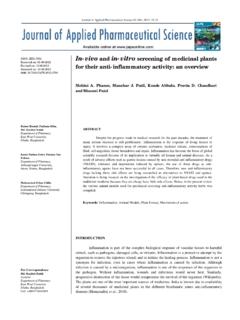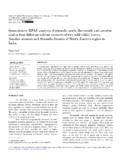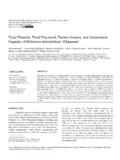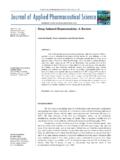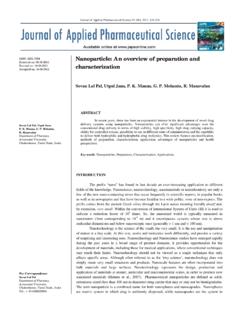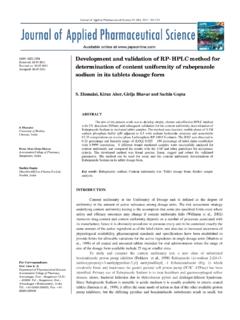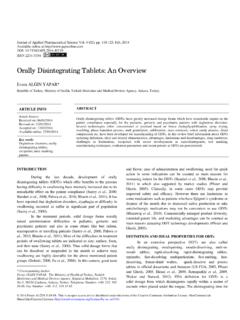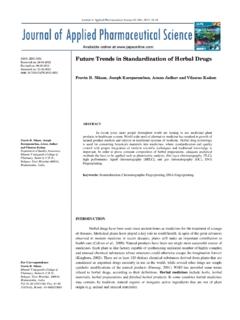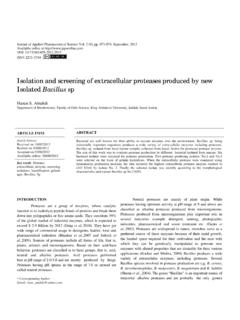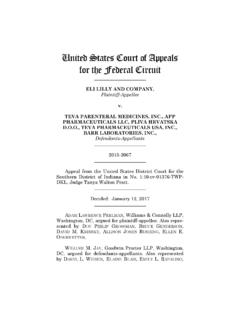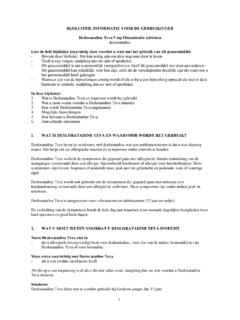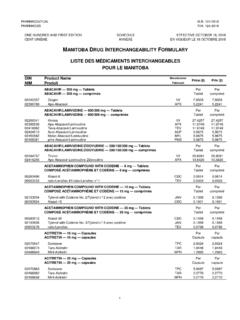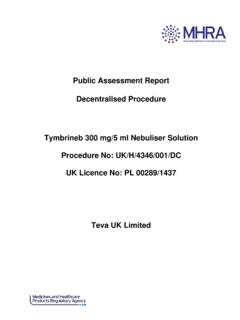Transcription of rmacological and Pharmaceutical Profile of Valsartan: A …
1 Journal of Applied Pharmaceutical Science 01 (04); 2011: 12-19 ISSN: 2231-3354 Received: 27-05-2011 Accepted: 10-06-2011 Nadeem Siddiqui, Asif Husain, Lakshita Chaudhry, M Shamsher Alam Department of Pharmaceutical Chemistry, Faculty of Pharmacy, Jamia Hamdard (Hamdard University), New Delhi, India Moloy Mitra and Parminder S. Bhasin Analytical Research, Ranbaxy Research Laboratories, Gurgaon, India *For Correspondence: E-mail: Pharmacological and Pharmaceutical Profile of Valsartan: A Review Nadeem Siddiqui, Asif Husain, Lakshita Chaudhry, M Shamsher Alam, Moloy Mitra and Parminder S.
2 Bhasin ABSTRACT Angiotensin II Receptor type 1 antagonists have been widely used in treatment of diseases like hypertension, heart failure, myocardial infarction and diabetic nephropathy. Their beneficial effects are related to inhibition of Angiotensin II by blockade of AT1 receptor. Valsartan is an orally active Angiotensin II receptor type 1 antagonist which causes reduction in blood pressure and is used in treatment of hypertension. It was first developed by Novartis and has a wide market in the developed and the developing countries. It is also available in combination with other antihypertensive drugs. It is a lipophilic drug and possesses moderate onset of action than other drugs of the same category.
3 The drug is a very good target for the generic industries. This review evaluates the pharmacological properties of Valsartan and its efficacy and tolerability in the treatment of patients with hypertension. A brief discussion has also been made on the current and future aspects of the drug in the market. Key words: Valsartan, hypertension, diabetes mellitus, spectrophotometry, ACE inhibitors INTRODUCTION Valsartan is a potent, orally active nonpeptide tetrazole derivative and selectively inhibits Angiotensin II Receptor type 1 (Flesch et al., 1997) which causes reduction in blood pressure and is used in treatment of hypertension. It was first developed by Novartis and has a wide market in the developed and the developing countries.
4 It is also available in combination with other antihypertensive drugs. It is a lipophilic drug and possesses moderate onset of action than other drugs of the same category. The drug is a very good target for the generic industries. It is soluble in the neutral pH range. It belongs to the BCS class III drug classified as low permeability and high solubility drug. Valsartan is soluble in acetonitrile and methanol. The drug is rapidly absorbed orally and has limited volume of distribution and is extensively bound to plasma proteins. Valsartan is not extensively metabolized and is mainly excreted by non-renal routes.
5 Valsartan is effective in treatment of pediatric, adolescents and the elderly patients with mild to moderate hypertension. Monotherapy with Valsartan with 80 mg as the starting dose has shown considerable efficacy in patients with CHF and renal impairment alongwith hypertension and add on therapy helped control BP in large population of patients with severe hypertension not responding sufficiently to -blockers, ACE inhibitors or diuretics. The importance of aggressive blood pressure control is undisputed, but the therapeutic focus is now extending to end-organ protection as a treatment goal of equal importance to BP reduction.
6 Thus, the value of ARBs like Valsartan in slowing the progression of kidney disease due to high blood pressure or diabetes has very positive medical as well as commercial implications. Many clinical trial studies like VALUE, VALIANT, VAL-Heft, PREVAIL and many more have been conducted of which valsartan administration is a part. From these studies comparison of valsartan with other antihypertensives Journal of Applied Pharmaceutical Science 01 (04); 2011: 12-19 have been made extensively. Valsartan was well tolerated in clinical studies and with most treatment related adverse effects related to the drugs of same category and ACE inhibitors.
7 Many analytical methods have been developed for the quantitation and determination of valsartan in biological fluids and Pharmaceutical dosage form. HISTORY Valsartan was first developed by Novartis and was sold under the brand name DIOVAN and it currently holds the largest market share for the drug of its kind in the market. In the USA, valsartan is registered by the Food and Drug Administration (FDA) for use in the treatment of hypertension in children of 6 years and older and adolescents in the December 2008. Present and Future Scenario Diovan (valsartan) was labelled as the world s number-one selling high blood pressure medication and accounted for $6 billion in sales in 2010 worldwide.
8 In near future its patent protection on its active ingredient is ready to expire in most of the major are two types of dosage forms of valsartan available in the market. One comprising of single-active component valsartan and other comprising three dosage froms containing a combination of valsartan with one or more active ingredients hydrochlorothiazide, amlodipine besylate, aliskiren hemifumarate. Ranbaxy Laboratories filed a Paragraph IV certification in 2007 and claimed the US5399578 patent as invalid and thereby pledged not to make, use, sell, offer to sell, or import Valsartan until November 2012 expiry date.
9 Ranbaxy along with Teva has got tentative approval for many strengths of the tablet and is expecting 180 days exclusivity and being first to file upon the expiry of the US5399578 patent. Data exclusivity (DE) delays generic competition even if the patented period has expired and hence is a cause for trouble for companies interested in developing a generic equivalent. As the DE periods for the combination periods by Novartis are scheduled to expire in US (Valsartan/Hydrochlorothiazide expiring in 2011; Valsartan/ Hydrochlorothiazide/Amlodipine and Valsartan/ Aliskiren expiring in 2012). Similarly in Europe, data exclusivity for Valsartan alone has expired, and the combination products are scheduled to expire as follows: Valsartan/Aliskiren expiring in 2017 and Valsartan/Hydrochlorothiazide/Amlodipine expiring in 2019.
10 Hence, the originator of Valsartan, Novartis aims to secure its credentials in the market by focusing the combination products by convincing the medical practitioners and patients with their benefits. The combination of Valsartan and Hydrochorothiazide is not protected by any patent but only the Valsartan molecule, hence the generic versions of this product is expected to be launched at the same time as the single active product. From the past eight years, it has been observed that there has been an increase in the patent filing of Valsartan and its combination products clearly indicating the importance of the drug molecule.
